Nemec has been used sparingly this season, playing only nine games and averaging 16:07 time-on-ice, down nearly four minutes from the 19:52 he averaged last season. The 20-year-old Slovak had 19 points (3G / 16A) in 60 games last season.

Nemec has been used sparingly this season, playing only nine games and averaging 16:07 time-on-ice, down nearly four minutes from the 19:52 he averaged last season. The 20-year-old Slovak had 19 points (3G / 16A) in 60 games last season.

With the Flames recently placing Anthony Mantha (lower body) on Injured Reserve, they have recalled Hunt from the Calgary Wranglers (AHL). The 28-year-old Hunt played 28 games with the Flames last season, scoring eight points (3G / 5A).

Carlsson has not played a game with the Sharks this season and will start his 2024-25 campaign with the San Jose Barracuda. The 27-year-old Carlsson scored 39 points (15G / 24A) in 52 games with the Charlotte Checkers (AHL) last season.

Richard played nine games with the Boston Bruins last season, scoring three points (1G / 2A), but has primarily been an AHL player since being drafted in the fourth-round of the 2015 NHL Entry Draft by the Nashville Predators. The 27-year-old Richard has nine points (4G / 5A) in seven games with the Lehigh Valley Phantoms (AHL) this season).

Jones struggled to find his place in the lineup in his first season in Boston, being limited to only four games, scoring zero points a -4 plus/minus. The 26-year-old Jones has not played in the AHL since an eight-game stint with the San Diego Gulls in the 2019-20 season.

The Capitals recalled Iorio after placing Jakob Chychrun on Injured Reserve but did not draw into the lineup. Iorio, who appeared in six NHL games last season, has scored one goal with two assists (three points) in nine AHL games this season.

Hayden made his season debut on Tuesday, playing 8:54 time-on-ice, in Seattle's 6-3 loss to the Colorado Avalanche. Hayden has 249 games of NHL experience since being drafted in the third round by the Chicago Blackhawks in the 2013 NHL Entry Draft but had been limited to only nine games since the end of the 2021-22 season.

Fleury played his second game of the season on Tuesday, recording 11:11 time-on-ice in Seattle's 6-3 loss to the Colorado Avalanche. The 25-year-old Fleury has been repeatedly back and forth from the AHL this season, mostly paper transaction, and will likely return Seattle's lineup before long.

Winterton played 9:28 time-on-ice in Seattle's 6-3 loss to the Colorado Avalanche on Tuesday, his season debut. Winterton was the third-round pick, 67th overall, of the Seattle Kraken in the 2021 NHL Entry Draft. The 21-year-old had a nine-game stint with Seattle last season, scoring zero points. He has five points (3G / 2A) in seven games with the Coachella Valley Firebirds (AHL) this season.

With Connor McDavid set to make his return from a lower-body injury, Philp has been sent down to the Bakersfield Condors (AHL). Philp made his NHL debut this season and played three games with McDavid was out of the lineup, averaging 10:13 time-on-ice and recording his first career point (0G / 1A).

Giles is a Boston College product that spent the previous three season with the Charlotte Checkers (AHL) before making his NHL debut this season. The 24-year-old Giles averaged 7:23 time-on-ice and scored zero points in nine games with the Panthers.

Milne was the third-round pick, 89th overall, of Minnesota in the 2022 NHL Entry Draft. The 22-year-old has spent the previous three seasons exclusively in the AHL, including scoring eight points (4G / 4A) through 10 games with the Iowa Wild (AHL) this season.

Perreault was the 27th overall pick of the Anaheim Ducks in the 2020 NHL Entry Draft. He has one NHL game under his belt but has spent most of his professional career in the AHL. He had two points (1G / 1A) in 13 games with the Laval Rocket (AHL) last season.

Kapanen was the 64th overall pick of the Canadiens in the 2021 NHL Entry Draft. The 21-year-old Kapanen made his NHL debut this season, scoring two points (0G / 2A) in 12 games with the Canadiens.

Condotta is an undrafted 27-year-old that made his professional debut in the 2021-22 season with the Laval Rocket (AHL). He has four games of NHL experience and has four points (0G / 4A) in nine games in the AHL this season.

With Zach Benson (lower body) ready to return from a five-game absence, Kulich has been sent down to the Rochester Americans (AHL). The 20-year-old Kulich scored one point (1G / 0A) in eight games with the Sabres this season.

With Macklin Celebrini and Ty Dellandrea both returning from injuries, the Sharks have assigned Ethan Cardwell and Danil Gushchin to the San Jose Barracuda (AHL). The 22-year-old Cardwell went scoreless in three games with the Sharks and with return to the Barracuda, where he has one goal and four assists through six AHL games.

With Macklin Celebrini and Ty Dellandrea both returning from injuries, the Sharks have assigned Ethan Cardwell and Danil Gushchin to the San Jose Barracuda (AHL). The 22-year-old Gushchin had one point (0G / 1A) while averaging 12:07 time-on-ice with the Sharks this season.

Caggiula was recalled last week from Bakersfield (AHL) and played two of three games for Edmonton, averaging 7:36 time-on-ice and recording one point (0G / 1A). He has been loaned back to Bakersfield where he has five points (2G / 3A) in five games this season.

Raty has played three games with Vancouver this season, scoring one point (0G / 1A), but has spent most of the 2024-25 campaign in Abbotsford (AHL), tallying seven points (3G / 4A) in eight games. The 21-year-old Raty was the 52nd overall pick of the New York Islanders in the 2021 NHL Entry Draft.
